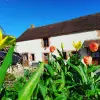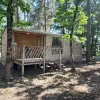Romorantin-Lanthenay is a town in Loir-et-Cher, in the Center-Loire Valley region. It is considered the capital of Sologne, a natural region between Loire and Cher. Formerly a swampy area during the reign of Napoleon III, the Sologne remains famous for its forests and ponds, and prized by hunters.
Located 30 km north-west of Vierzon and 65 km south of Orléans, Romorantin (which merged with the village of Lanthenay in 1961) developed on the course of the Sauldre, a tributary of the Cher. Fortified city in the Middle Ages, it passes in the 15th century under protection of the counts of Angoulême who build a new castle.
At the beginning of the 16th century, Francis I asked Leonardo da Vinci to design a new town in Romorantin (the birthplace of his wife) and to build his royal residence there. The project does not see the light and the king sets his sights on Chambord.
Already known for its textile units under Louis XIV, Romorantin benefited in the nineteenth century from the success of Normand brothers draperies, founded in 1815, which employed up to 2,000 workers. When they were closed, a factory was set up in 1970 in Matra, where Renault Espace cars were produced. With a workforce of up to 3,000 employees, the plant closed in the early 2000s.
However, Romorantin-Lanthenay (17,500 inhabitants) retains its attractiveness. Its rich historical heritage and its cultural vitality in the heart of a unique environment make it a tourist stop of choice.
A journey through the city allows to admire a rich architectural heritage.
Religiously, this is the case of the church of Saint-Etienne, the oldest parts of which date back to the 11th century, the two churches of Lanthenay (12th century) or the vestiges of the former Bernardine abbey.
Also worth seeing is the monumental cross dedicated to Saint Lazare, built in the 19th century, on the site of an ancient sick-room or the Saint-Roch chapel (17th century).
Shared in several districts (the medieval city frequented by Francis I, the working city where the factories were established and the "green" city along the Sauldre), Romorantin-Lanthenay has also preserved many civil buildings of great interest.
Such as the hotel Saint-Pol, classified Historic Monument, built under Louis XII in the sixteenth century. Its emblem, a porcupine, adorns the facade. It is said that it was there that in 1521, Francis I was accidentally hit by a firebrand, then forced to grow his beard to conceal a disgraceful scar.
The Carré Doré, a timber-framed building housing the Archaeological Museum and the Chancellery, is a 15th or 16th century building on which many figures are sculpted.
In another style, the present town hall was formerly a private mansion (known as the Lionel-Normant Hotel), of classical style (19th century). In the landscaped park next to the building, there is a surprising Chinese pagoda which served as a water tower. It was bought during the 1900 Universal Exhibition.
There are also elements of the castle built in the 15th century by the ancestor of Francis I, the Count of Angoulême Jean de Valois. Such as the tower of the southeast tower that faces the Sauldre as well as the Prison Tower, to the northeast. This part, the oldest, was integrated into what was the fortified enclosure of the city in the twelfth and thirteenth centuries. The remainder of the castle has been badly damaged by time, these remains were completed in the 19th century and the whole now houses the sub-prefecture.
Finally, at the level of industrial architecture, we will not forget the door of the old textile factory where we can distinguish four heads of rams carved in the mass that symbolize the work of wool and represent fertility.
All of these sites and buildings are part of a heritage trail dotted with panels, which can be taken on foot. Plan and information on +33 2 54 94 41 56 or on +33 2 54 76 43 89.
During or after this discovery walk, a visit to the museums of the city is essential.
One can start with the Sologne museum, which was rehabilitated in new buildings (old mills) in 1989. On three buildings connected by a footbridge, spanning the Sauldre, there are 2,000 m² of exhibitions dedicated to Sologne, City and its heritage. Open Monday to Saturday from 10am to 12pm and from 2pm to 6pm, Sunday from 2pm to 6pm. Closed on Tuesdays. Information: +33 2 54 95 33 66. Attention: the museum was affected by the floods of June 2016 and was closed until the restoration work was completed (reopening on a date not yet known).
Also worth visiting is the Espace Automobiles Matra, which presents the history of the famous automobile company, a collection of sports cars and prototypes. Open from Monday to Sunday. Information on +33 2 54 94 55 58.
Finally, installed in the Golden Carpet, property of the Society of Art, History and Archeology of Sologne, the archaeological and geological museum presents a collection of prehistoric, Gallo-Roman and From the Middle Ages, largely from the region. Open all the year only by reservation on +33 2 54 76 22 06.
To enjoy the green spaces, you will choose a stroll on the island of La Motte which houses a leisure park (playground, mini-golf... Inquiries to +33 6 24 55 39 42). It is connected by a footbridge to the Island of the Poulies, which retains its natural aspect.
One can also discover the square Ferdinand Buisson, created in 1860, an English garden rich in varied species and remarkable trees.
Finally, there is, of course, the park of the town hall and its singular pagoda and especially, the park of the castle of Beauvais. Although off-center (on the road leading to the airport), the 13 hectares of the site are suitable for walking or cycling. Cultural and festive events are organized on a regular basis. The residential edifice of the eighteenth and nineteenth century, on the other hand, can not be visited.
For the sportsmen, we will mention the Alain Calmat complex. It has an ice rink (closed in summer, price from 2,60 to 4 euros) and a swimming pool (price: 1,60 and 2,50 euros). Information on +33 2 54 94 28 00.
For the many excursions to and from the city, to walk or mountain bike, dotted with heritage elements or the first landscapes of the surrounding Sologne, please inquire at +33 2 54 76 43 89










































